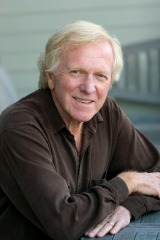Since 75 percent of Marin is open space (some say 80 percent—whatever!), we should feel extremely blessed to have so much undeveloped land so close to a major city. Yet for years many Marin outdoor enthusiasts have argued bitterly over how to best enjoy this incredible good fortune.
Hikers say mountain bikers are reckless; bikers say hikers control all the good trails; equestrians say both fail to respect the sensitive nature of horses; and environmentalists maintain all three elements are damaging Marin’s precious (and fragile) open space.
Remember these lyrics from the musical Oklahoma:
Oh, the farmer and the cowman should be friends. One man likes to push a plow, the other likes to chase a cow. But that’s no reason why they can’t be friends. Territory folks should stick together, territory folks should all be pals.
Substituting “Marin” for “territory,” I sang those lines to myself at a recent joint hearing of the Board of Supervisors and the county’s Open Space Commission. It was a sunny afternoon, more than 150 people attended, and 52 felt passionate enough to approach the microphone and let supervisors and commissioners know their views on the issues raging over Marin’s thousands of acres of open space.
Several bikers wanted designated “bicycle priority trails”; one hiker maintained that “mountain bikers don’t abide by the rules.” And so on. Although the discourse was mostly civil, it was surprisingly detailed and went on for longer than two hours. And the matter of dogs in open space areas never came up.
The critical factor for me, however, was that this hearing involved only the lands of Marin Open Space District which—with 14,000 acres in 33 preserves scattered throughout the county—is but one of five agencies overseeing Marin’s vast treasure of undeveloped land.
What about the others? Marin Municipal Water District manages 20,000 acres of watershed with 160 miles of unpaved roads and trails, most of which are on the east side of Mount Tam. The county also contains seven state parks totaling almost 14,000 acres, the largest being Mount Tamalpais, with 60 miles of trails mostly on the west slope. The Golden Gate National Recreation Area controls approximately 45,000 acres of Marin, stretching from Sausalito to Stinson Beach and including the Marin Headlands and the popular Tennessee Valley trail network. Finally, in West Marin the Point Reyes National Seashore has more than 33,000 acres crossed with 150 miles of unpaved roads and scenic trails.
These agencies have differing rules regarding mountain biking, hiking and equestrian use. And let’s be honest: who but the most avid Marin hiker/biker/runner/equestrian knows whether he or she’s on land controlled by the county, California State Parks, the GGNRA, the MMWD or the Point Reyes National Seashore? Moreover, it is doubtful that any of these agencies has the wherewithal or the funding to enforce their rules.
That said, and after conferring with people far more involved than I, here are six commonsense trail courtesies that could easily apply to all Marin open spaces regardless of who controls them:
1. Whether hiking, biking or horseback riding, maintain an attitude of mutual respect and civility and always stay on established trails and fire roads.
2. Never hike, bike, run or ride on muddy trails. Such use creates deep ruts, wider trails and drainage issues.
3. All trail users should obey posted rules, especially those prohibiting bikers and equestrians from using narrow, single-track trails.
4. Regarding dogs, it’s best to “love ’em and leash ’em.” On narrow, single-track trails, leashes are required. On fire roads, firm voice control suffices. Disposal bags are always required. (Exception: dogs are not allowed on state park and GGNRA trails.)
5. When on a steep narrow trail, downhill hikers should give way to hikers headed uphill.
6. When approaching equestrians on either a wide trail or a fire road, hikers should acknowledge riders and yield and control dogs as needed; bikers should offer to dismount.
Please remember, these are not laws. They are common courtesies involving common sense. And as with so many aspects of our contemporary life, that may be all it takes to bring peace to the mountains . . . and friendship on the trail. That’s my point of view. What’s yours?
E-mail [email protected].


